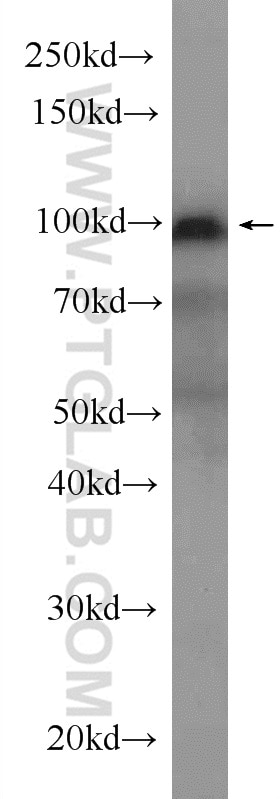Tested Applications
| Positive WB detected in | mouse thymus tissue, human blood tissue |
| Positive IHC detected in | mouse spleen tissue Note: suggested antigen retrieval with TE buffer pH 9.0; (*) Alternatively, antigen retrieval may be performed with citrate buffer pH 6.0 |
Recommended dilution
| Application | Dilution |
|---|---|
| Western Blot (WB) | WB : 1:500-1:1000 |
| Immunohistochemistry (IHC) | IHC : 1:50-1:500 |
| It is recommended that this reagent should be titrated in each testing system to obtain optimal results. | |
| Sample-dependent, Check data in validation data gallery. | |
Published Applications
| WB | See 2 publications below |
| IHC | See 1 publications below |
Product Information
17642-1-AP targets C7 in WB, IHC, ELISA applications and shows reactivity with human, mouse, rat samples.
| Tested Reactivity | human, mouse, rat |
| Cited Reactivity | human |
| Host / Isotype | Rabbit / IgG |
| Class | Polyclonal |
| Type | Antibody |
| Immunogen |
CatNo: Ag11819 Product name: Recombinant human C7 protein Source: e coli.-derived, PGEX-4T Tag: GST Domain: 310-690 aa of BC063851 Sequence: GGEYRVLFYVDSEKLKQNDFNSVEEKKCKSSGWHFVVKFSSHGCKELENALKAASGTQNNVLRGEPFIRGGGAGFISGLSYLELDNPAGNKRRYSAWAESVTNLPQVIKQKLTPLYELVKEVPCASVKKLYLKWALEEYLDEFDPCHCRPCQNGGLATVEGTHCLCHCKPYTFGAACEQGVLVGNQAGGVDGGWSCWSSWSPCVQGKKTRSRECNNPPPSGGGRSCVGETTESTQCEDEELEHLRLLEPHCFPLSLVPTEFCPSPPALKDGFVQDEGTMFPVGKNVVYTCNEGYSLIGNPVARCGEDLRWLVGEMHCQKIACVLPVLMDGIQSHPQKPFYTVGEKVTVSCSGGMSLEGPSAFLCGSSLKWSPEMKNARCVQ Predict reactive species |
| Full Name | complement component 7 |
| Calculated Molecular Weight | 843 aa, 94 kDa |
| Observed Molecular Weight | 105 kDa |
| GenBank Accession Number | BC063851 |
| Gene Symbol | C7 |
| Gene ID (NCBI) | 730 |
| RRID | AB_1959350 |
| Conjugate | Unconjugated |
| Form | Liquid |
| Purification Method | Antigen affinity purification |
| UNIPROT ID | P10643 |
| Storage Buffer | PBS with 0.02% sodium azide and 50% glycerol, pH 7.3. |
| Storage Conditions | Store at -20°C. Stable for one year after shipment. Aliquoting is unnecessary for -20oC storage. 20ul sizes contain 0.1% BSA. |
Background Information
The complement system is an important effector that bridges the innate and adaptive immune systems (PMID: 20010915). Complement component 7 (C7) is a single-chain plasma glycoprotein that is the final product of the complement cascade and plays a central role in the activation of the complement system. It is a constituent of the membrane attack complex (MAC) that plays a key role in the innate and adaptive immune response by forming pores in the plasma membrane of target cells (PMID: 10886232; PMID: 27852032). C7 is a potential tumor suppressor and a prognostic biomarker for prostate cancer and renal cell carcinoma (PMID: 32984006; PMID: 33158953). C7 serves as a membrane anchor. People with C7 deficiency are prone to bacterial infection (PMID: 19758139).
Protocols
| Product Specific Protocols | |
|---|---|
| IHC protocol for C7 antibody 17642-1-AP | Download protocol |
| WB protocol for C7 antibody 17642-1-AP | Download protocol |
| Standard Protocols | |
|---|---|
| Click here to view our Standard Protocols |
Publications
| Species | Application | Title |
|---|---|---|
Mol Cell Proteomics Proteomic landscape of exosomes reveals the functional contributions of CD151 in triple-negative breast cancer. | ||
Mol Cell Proteomics Proteomic analysis of human follicular fluid-derived exosomes reveals that insufficient folliculogenesis in aging women is associated with infertility |








